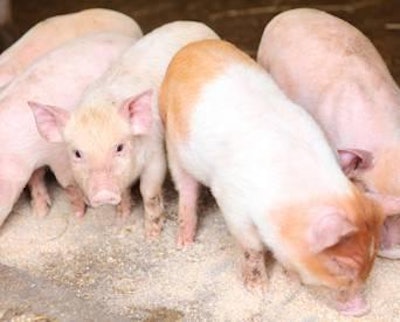
Intake of creep feed is highly variable and largely unpredictable, as variability exists not only among but also within litters. In general, intake of creep feed increases and becomes more predictable as age at weaning is delayed, especially past the mark of 21 days.
Creep feed consumption
Most authorities agree that creep feeding is beneficial mainly in production systems where pigs are weaned beyond the third week of age, at least when benefits considered involve heavier weaning weight and post-weaning growth rate. Pigs weaned before the third week of age concentrate their efforts in stimulating milk production by the sow, rather than supplementing their diet with solid creep feed.
It is notable that neonatal pigs will not consume a highly digestible and palatable creep diet even though they have the genetic potential of almost doubling their growth rate. Even liquid milk replacers enhance pre-weaning growth rate to a limited degree when pigs are weaned before the third week of lactation; and then only when they are faced with adverse conditions. Nevertheless, some pigs start sampling creep feed even during the first week of age, and quite a few become regular eaters consuming substantial quantities of feed. On average, however, consumption is extremely limited and rarely exceeds 10-50 g/day per piglet.
Intake of creep feed becomes substantial, yet still insufficient to fully cover nutrient needs for genetic potential, during the fourth week of lactation. During this time, the majority of pigs consume at least some creep feed, whereas a small proportion may consume large quantities regularly (up to 500 g/day). On average, creep feed intake in pigs weaned around four weeks of age is about 100 g/day per piglet.
For pigs weaned later than four weeks of age, creep feed intake increases almost linearly and may reach up to 1 kg/day in pigs weaned at eight weeks of age. However, variation remains extremely high even at this late age and greatly affects piglet growth rates. For example, in a study where pigs were weaned at 8 weeks of age, intake of creep feed ranged from 0 to almost 1,600 g/day per piglet during the last week of lactation, with pigs weighing from 6 to 27 kg in body weight at the time of weaning.
Benefiting from creep feeding
Substantial intake of creep feed confers the benefits of heavier pigs at weaning and the digestive experience of solid feed. Heavier pigs at weaning not only grow faster throughout market age, but they also require less complex diets during the post-weaning period. Pigs with sufficient experience in consuming solid feed during lactation suffer less from post-weaning anorexia. Thus, their growth is penalized less by the weaning event, and their digestive system remains healthier.
It has been suggested that at least 500 g feed must be consumed before weaning for young pigs to truly benefit from creep feeding. Consumption of insufficient quantities of solid feed (less than 500 g/pig) might trigger an enteric allergenic reaction to certain dietary antigenic proteins (as in soybean meal), but it does not allow for education of the digestive immune system to handle such proteins at weaning.
Commercial practice indicates that creep feeding is seldom employed in pigs weaned before 18-19 days of age, whereas it is universally adopted as a necessity for pigs weaned at 35+ days of age. Most users claim pigs adapt better to post-weaning diets, even though weaning weights may not be enhanced. Creep feeding has seen resurgence in popularity with modern hyper-prolific sow genetics and as a less expensive alternative to milk replacers offered in farrowing crates.

















